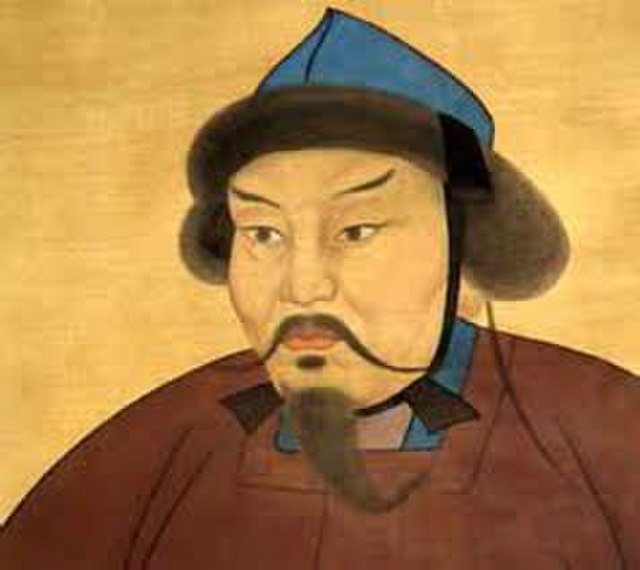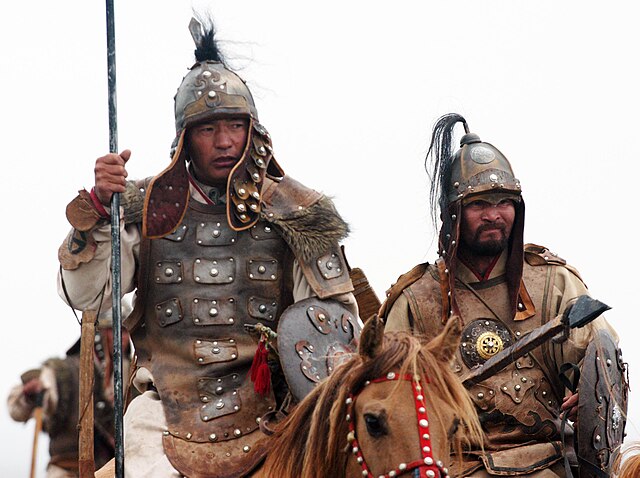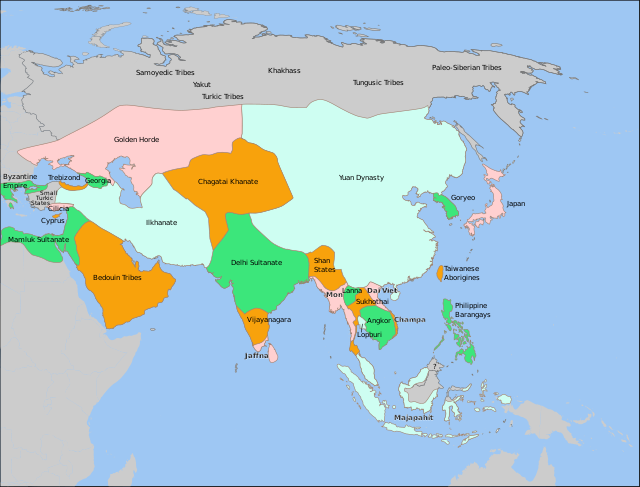The Mongol Empire was the largest contiguous land empire in history, spanning over 33 million km2 at its peak in the 13th century CE under the rule of Genghis Khan and his successors.[1] The nomadic Mongol tribes of Central Asia united in the early 13th century and swiftly conquered most of Eurasia through a combination of military tactics, discipline, and terror. Within just a few decades, the once-fragmented Mongol tribes established an empire that stretched from Eastern Europe to the Sea of Japan.
The Rise of Genghis Khan
The foundations of the Mongol Empire were laid by Genghis Khan, born as Temüjin, son of a Mongol chieftain.[2] Temüjin began uniting the Mongol tribes in 1206 and took the title Genghis Khan or “Universal Ruler.” Through cunning political maneuvers and ferocious military skills, Genghis Khan subjugated all tribes of the Mongolian Plateau by 1209.
Genghis Khan implemented a meritocratic method of promotion, loyalty to the Khan over tribe, castration of royal sons to avoid succession conflicts, and military training from childhood. These reforms created a formidable Mongol army.[3] Soldiers were organized into tightly controlled units of 10 without noble titles. They were highly mobile, traveling with multiple horses. The all-cavalry force emphasized speed and adaptability over defense and heavy weaponry.

With a unified Mongol nation under his rule, Genghis Khan could turn his sights to conquest. The first campaigns targeted the Western Xia and Jin dynasties of northern China from 1209 to 1215.[4] Genghis Khan invaded the Khwarezmid Empire in 1219, after its Shah killed Mongol envoys. This campaign reached as far west as the Caucasus Mountains and provided the Mongols experience with Islamic armies.
Conquest of China and Korea
Genghis Khan died in 1227 during a campaign against the Xi Xia dynasty in northwest China. His successor and son Ögedei Khan pursued the conquest of the remainder of northern China over the following decade.[5] All of northern China was under Mongol rule by 1234 with the fall of the Jin dynasty. The Southern Song dynasty in southern China remained independent until the 1270s when Kublai Khan, Genghis Khan’s grandson, crushed fierce resistance to complete the Mongol conquest of China.[6]
The Mongols invaded Korea during their war against the Jin dynasty, forcing Korea to become a vassal state in 1259. The Mongols maintained influence over Korea until 1356.[7] Repeated Mongol invasions of Japan in 1274 and 1281 also extended imperial control into the seas of East Asia. However, both invasion attempts were ultimately defeated by storms that the Japanese termed kamikaze or “divine wind.”

Westward Expansion
The Mongol conquests continued beyond China, encouraged by the vast grasslands of the Eurasian steppe that facilitated trade and communication.[8] Mongol armies struck westward into territories controlled by their old Khwarezmid enemies in Central Asia and Persia from 1219 to 1224. The Persian Khwarezmid Empire capitulated after a year while Central Asia took longer to subjugate.
Farther west, the Mongols launched attacks on Kievan Rus’ principalities beginning in 1223.[9] Mongol domination of the Russian steppes separated Rus’ cities from each other and opened them to more attacks over the following decades. The Mongols conquered the Caucasus region, including Armenia and Georgia, from 1236 to 1243. They defeated Eastern European armies at battles like Legnica and Mohi as they extended control into Poland, Hungary, and the Balkans throughout the 1240s.

The Mongols swept through the Middle East from 1219 onward, destroying the Islamic caliphates that resisted them. In 1258, Hulagu Khan, grandson of Genghis Khan, seized Baghdad and executed the last Abbasid Caliph, al-Musta’sim.[10] The Mongols soon controlled a unified swath of territory from China through Central Asia, Persia, and Anatolia.
Pax Mongolica
The rapid Mongol expansion integrated east and west Eurasia into a “Pax Mongolica” of safe trade and communication.[11] Mongol rulers allowed merchants and missionaries to traverse the empire’s territory relatively freely once conquered. Envoys from Europe even found their way to the court of the Great Khan in Mongolia.
The Mongols enabled connections between cultures across Eurasia that had been more isolated before. Chinese technologies like printing and gunpowder disseminated west along the protected Mongol trade networks. The Persian administrative traditions and postal system reached Russia and China with the expanding empire.[12] The Pax Mongolica eased transmission not only of goods and ideas but also the Black Death pandemic of the 14th century.
fall
The Mongol Empire ultimately failed to outlast the lives of its founder Genghis Khan and his sons and grandsons. By 1368, just over a century after Genghis Khan’s death, the empire had fractured into smaller khanates and kingdoms.[13] However, the remnants of the unified empire continued influencing regional history for centuries. Descendants of Genghis Khan’s relatives founded their own empires, including the Timurid Empire of Central Asia and the Northern Yuan dynasty in Mongolia.
Several factors contributed to the dissolution of the Pax Mongolica and unity of the Mongol Empire. Frequent succession struggles resulted from the custom of splitting lands between sons of a ruler. As non-Mongols increasingly filled the ranks of the military, ethnic cohesion declined. The outbreak of bubonic plague likely also weakened the empire’s foundations. Lastly, Mongol rulers ultimately failed to transition from a tribal confederation to a stable dynastic structure. [14]
Nonetheless, while short-lived, the Mongol Empire achieved an unprecedentedly large, demographically diverse territorial empire in the medieval world. The Mongol conquests linked civilizations across continents, spurring cross-cultural exchange and laying the groundwork for the modern age of globalization.
Sources
[1] “Largest Empires In Human History By Land Area.” WorldAtlas, www.worldatlas.com/articles/largest-empires-in-human-history.html. Accessed 15 Nov. 2023.
[2] Weatherford, J. McIver. Genghis Khan and the Making of the Modern World. Three Rivers Press, 2004.
[3] De Hartog, Leo. Genghis Khan: Conqueror of the World. Tauris Parke Paperbacks, 2004.
[4] Mote, F.W. Imperial China, 900–1800. Harvard University Press, 2003.
[5] Franke, Herbert and Denis Twitchett. The Cambridge History of China, Volume 6: Alien Regimes and Border States, 907–1368. Cambridge University Press, 1994.
[6] Ebrey, Patricia. The Cambridge Illustrated History of China. Cambridge University Press, 2010.
[7] Lee, Ki-Baik. A New History of Korea. Translated by Edward W. Wagner and Edward J. Shultz, Ilchokak, 1984.
[8] di Cosmo, Nicola, et al. The Cambridge History of Inner Asia: The Chinggisid Age. Cambridge University Press, 2018.
[9] Halperin, Charles J. Russia and the Golden Horde: The Mongol Impact on Medieval Russian History. Indiana University Press, 1987.
[10] Saunders, J. J. The History of the Mongol Conquests. University of Pennsylvania Press, 2001.
[11] May, Timothy. The Mongol Empire: A Historical Encyclopedia. ABC-CLIO, 2016.
[12] Allsen, Thomas T. Culture and Conquest in Mongol Eurasia. Cambridge University Press, 2004.
[13] Morgan, David. The Mongols. Wiley-Blackwell, 2019.
[14] Weatherford, J. McIver. The Secret History of the Mongol Queens: How the Daughters of Genghis Khan Rescued His Empire. Broadway Books, 2010.